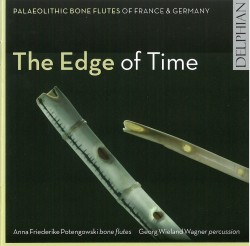 The Edge of Time – Paleolithic Bone Flutes of France & Germany
The Edge of Time – Paleolithic Bone Flutes of France & Germany
Anna Friederike Potengowski; Georg Wiland Wagner
Delphian DCD34185
(delphianrecords.co.uk)
Toward the end of the last Ice Age modern humans began to settle Europe. From fragmentary cave finds and a few complete instruments, it appears that as early as 40,000 years ago these people made and played flutes of various kinds, primarily fashioned from hollow bird bones. These prehistoric flutes could well be the oldest known musical instruments fashioned by human hands. As such they represent the oldest evidence of music production, so closely associated with our species, on our blue planet.
Reconstructing these ancient flutes, and re-imagining their music, is problematic at its core, yet this contested terrain is precisely where the 16 tracks on The Edge of Time – Paleolithic Bone Flutes of France and Germany takes a stand. Classically trained German flutist Anna Friederike Potengowski began to study the four reconstructed bone flutes used on this album and their possible playing techniques in 2010 and formed VentOs with percussionist and composer Georg Wieland Wagner.
Their program of compositions and improvisations reflects an aesthetic deeply rooted in European classical music, the heritage of the two performer/composers. It’s seen in the choices of music vocabulary, extended instrumental techniques, breathing, phrasing and general performance practice. No surprise then that the flutes as played by Potengowski generally closely adhere to tones in the modern standard 12-tones-per-octave scheme, pitched at A=440 Hz.
Make no mistake however; Potengowski gives virtuoso performances on her instruments. Echoing melodies (the original flutes were all found stashed in caves), bird-like calls and breathy nature sounds are sometimes performed solo, but in most cases are accompanied by Wagner splashing water against stones, rustling grasses, chanting and playing marimba arpeggios and bombastic tympani rhythms. The longest, and for me the most successful, complete work is a performance of John Cage’s Ryoanji (1983-85) score, a haunting study of breathy glissandi by all four bone flutes and two insistent, though asymmetrically beating, stone flints. Yet I still wonder how the music played on these flutes might have sounded in the hands of their Ice Age creators.



